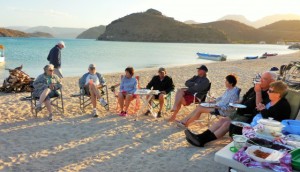
February 16, 2015 – Today the sun is scheduled to reappear as we continue our southward journey to Ciudad Constitucion on our way to Cabo San Lucas. This is a very different start to our day yesterday, where the lightning and thunder, followed by lots of rain (buckets) awoke me at about 4am and continued for some time. It did clear up for our excursion to San Javier, the road was in ok shape except for dodging some rocks. We had a good look around and returned under mostly sunny and warm skies. Then after some errands in the early part of the afternoon the thunder and lightning started again and it poured. About an hour before our Baja Fiesta Dinner the precipitation stopped and before you knew it we were loading up the Van and Giggling Dolphin bound. We able to park at the gate to the restaurant, good thing the water was 6 inches deep on the street and went curb to curb, I had to exit thru the sliding side door myself. Dinner was good, Ubaldo always the gracious and attentive host and the musicians performed some new tunes thanks to Gus’s requests, yet another Baja experience to remember.

We have had an actioned packed tour with whale watching in Guerrero Negro, Malarrimo Eco Tours do such a good job. The entire gang went, the lagoon was like glass and they were greeted by over 2000 grey whales in the bay. Great photos and an experience of a lifetime they will never forget, many can now say “I touched a whale!” Following their return we headed off to San Ignacio, a date palm oasis. We stopped briefly at the Military Checkpoint north of town and before you could say Baja Amigos we departed for the village. Date cakes and Tortillas were very popular with most and our return to Rice & Beans we made reservations for dinner. The group consensus was the same as those that went before, Rice & Beans margaritas were fabuloso! .

Day 6 and we were off to the beach and Playa Santispac in Bahia Concepcion. We arrived under sunny skies and some wind. After set up Bruce and I headed into Mulege to place a call to Dom and Bruce had a few errands to run. Later Roland & Janice hosted a Happy Hour to thank everyone for the help and understanding with the flat repairs (2 in 2 days) at the outset of the tour. We met our neighours Pate & Cindy from California and Dave & Denise from the Sunshine Coast in BC. The next day the wind was down and we took the Kayak off for folks to try out. Bruce & Marian provided the fire wood but could not make the Potluck which was terrific. Later with some wind we had a great campfire on the beach listening to some tunes, was nice. On the beach we saw Steve & Dale (Placerville), Gord & Kathy (Rossland) and George (Peachland) who we first met over 10 years ago on El Requeson.

Day 8 we were Loreto bound, home of both Baja and Alta California. We really enjoy this short drive along the bay and then crossing over to adjacent to the mountains. All without incident or problem until we hit town. After crossing off the parallel road over Mex 1 we heard a pop and jetting air, yes another flat tire, this time on the trailer. Fortunately this was excellent spot for the caravan to pull off and 30 minutes later thanks to Dennis, Ron and others we were on our way. We drove onto the Malecon to find out it was blocked off for Carnaval, no problemo we turned at Benito Juarez then onto Davis for our lineup in front of the hotel. We took everyone in, one at a time, plus we had others arrive at the same time including Paul & Lise form our January tour who had dropped off in La Paz. Later we toured town and went to the Ley Express ATM. It was Valentines Day so we went out for dinner at Isla’s joined by Roland & Janice (it was great). Other also went to Islas Restaurant, some to La Mision. Caranaval was on so we checked it out and caught a performance on stage before turning in for the evening.

Did you know?
The Republic of Sonora was a declared federal republic composed of two states: the controlled Baja California (present day Baja California and Baja California Sur) and non-controlled Sonora between January 10th and May 8th, 1854. This was led by William Walker (May 8, 1824 – September 12, 1860) an American lawyer, journalist, soldier and adventurer, who organized several private military expeditions into Latin America, with the intention of establishing English-speaking colonies under his personal control, an enterprise then known as “filibustering.” Walker became president of the Republic of Nicaragua in 1856 and ruled until 1857, when he was defeated by a coalition of Central American armies. He was subsequently executed by the government of Honduras in 1860.
William Walker, was an American of Scottish decent, 29 years old, of strong personal characteristics and adventurous nature, after a varied career, first conceived the idea of forming independent republics in certain districts of Mexico we believe in 1953. He concluded the remoteness and sparse settlement of whose districts made the plan seem this seem feasible. He was impelled, no doubt, largely by an emulative spirit of jealousy toward the dashing French Count, Raoul Raousset, whose operations in northwestern Mexico had a somewhat similar purpose. Walker was born in Nashville, Tennessee, in 1824 to James Walker and his wife Mary Norvell. His father was a son of a Scottish immigrant, his mother was a daughter of Lipscomb Norvell, an American Revolutionary War officer from Virginia. One of Walker’s maternal uncles was John Norvell, a US Senator from Michigan and founder of The Philadelphia Inquirer. William Walker was engaged to Helen Martin, but they never married, and he died without any children.

William Walker graduated summa cum laude from the University of Nashville at the age of fourteen. He studied medicine at the University of Edinburgh and University of Heidelberg before receiving his medical degree from the University of Pennsylvania at the age of 19. He practiced briefly in Philadelphia before moving to New Orleans to study law. He practiced law for a short time, and then quit to become co-owner and editor of the New Orleans Crescent. In 1849, he moved to San Francisco, where he was a journalist and fought three duels; he was wounded in two of them. It was during this time period that Walker conceived the idea of conquering vast regions of Latin America and create new slave states to join those already part of the United States. These campaigns were known as filibustering or freebooting.
In the summer of 1853, William Walker traveled to Guaymas, seeking a grant from the government of Mexico to create a colony that would serve as a fortified frontier, protecting US soil from retaliations by Native Americans. Mexico refused, and Walker returned to San Francisco determined to obtain his colony, regardless of Mexico’s position. He began recruiting from amongst American supporters of slavery and the Manifest Destiny Doctrine, mostly inhabitants of Kentucky and Tennessee. His intentions then changed from forming a buffer colony to establishing an independent Republic of Sonora, which might eventually take its place as a part of the American Union (as had been the case previously with the Republic of Texas). He funded his project by “selling scripts which were redeemable in lands of Sonora.”

On October 15, 1853, Walker set out with 45 men to invade and conquer the Mexican territories of Baja California and Sonora. He succeeded in capturing La Paz, the capital of sparsely populated Baja California, which he declared the capital of a new Republic of Baja California, with himself as president and his partner, Watkins, as vice president; he then put the region under the laws of the American state of Louisiana, which made slavery legal. The declaration of independence from Mexico was written on January 10, 1854. Fearful of attacks by Mexico, Walker moved his position twice over the next three months, first to Cabo San Lucas, and then further north to Ensenada to maintain a more secure position of operations. Although he never gained control of Sonora, less than three months later, he pronounced Baja California part of the larger Republic of Sonora. Walker’s exploits generated large amounts of interest back in San Francisco, where bonds for the Republic of Sonora were sold and its flag was even raised in places. However, Walker was never able to take advantage of his project’s popularity. A serious lack of supplies, discontent within his party and an unexpectedly strong resistance by the Mexican government quickly forced Walker to retreat.
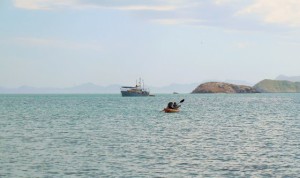
Back in California, Walker was put on trial for conducting an illegal war. The judge indicated that Walker was guilty of violating the peace treaty agreed upon by the United States and Mexico after the Mexican–American War (1846–48). However, it was the era of Manifest Destiny and consequently his filibustering project was popular in the southern and western United States. Because of this, the jury took only eight minutes to acquit him.
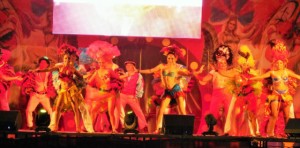
Then came Walker’s exploits in Nicaragua. In 1854, a civil war erupted in Nicaragua between the Legitimist Party (also called the Conservative Party), based in the city of Granada, and the Democratic Party (also called the Liberal Party), based in León. The Democratic Party sought military support from Walker who, to circumvent U.S. neutrality laws, obtained a contract from Democratic President Francisco Castellón to bring as many as three hundred “colonists” to Nicaragua. These mercenaries received the right to bear arms in the service of the Democratic government. Walker sailed from San Francisco on May 3, 1855, with approximately 60 men. Upon landing, the force was reinforced by 170 locals and about 100 Americans, including the well-known explorer and journalist Charles Wilkins Webber and the English adventurer Charles Frederick Henningsen, a veteran of the First Carlist War, the Hungarian Revolution, and the war in Circassia.
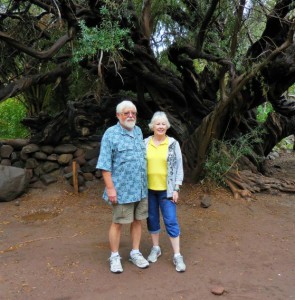
With Castellón’s consent, Walker attacked the Legitimists in the town of Rivas, near the trans-isthmian route. He was driven off, but not without inflicting heavy casualties. On September 4, during the Battle of La Virgen, Walker defeated the Legitimist army. On October 13, he conquered the Legitimist capital of Granada and took effective control of the country. Initially, as commander of the army, Walker ruled Nicaragua through provisional President Patricio Rivas. U.S. President Franklin Pierce recognized Walker’s regime as the legitimate government of Nicaragua on May 20, 1856. However Walker’s first ambassadorial appointment, Colonel Parker H. French, was refused recognition.

Walker took up residence in Granada and set himself up as President of Nicaragua, after conducting a fraudulent election. He was inaugurated on July 12, 1856, and soon launched an Americanization program, reinstating slavery, declaring English an official language and reorganizing currency and fiscal policy to encourage immigration from the United States. Realizing that his position was becoming precarious, he sought support from the Southerners in the U.S. by recasting his campaign as a fight to spread the institution of black slavery, which many American Southern businessmen saw as the basis of their agrarian economy. With this in mind, Walker revoked Nicaragua’s emancipation edict of 1824. This move did increase Walker’s popularity in the South and attracted the attention of Pierre Soulé, an influential New Orleans politician, who campaigned to raise support for Walker’s war. Nevertheless, Walker’s army, weakened by an epidemic of cholera and massive defections, was no match for the Central American coalition.

Meanwhile, C. K. Garrison and Charles Morgan, subordinates of Cornelius Vanderbilt’s Accessory Transit Company, provided financial and logistic assistance to the filibusters in exchange for Walker, as ruler of Nicaragua, seizing the Company’s property (on the pretext of a charter violation) and turning it over to Garrison and Morgan. Outraged, Vanderbilt dispatched two secret agents to the Costa Rican government with detailed plans on how to deal a death blow to the filibusters. They would help regain control of Vanderbilt’s steamboats which had become a logistical lifeline for Walker’s army.
Walker had also scared his neighbors and potential American and European investors with talk of further military conquests in Central America. Juan Rafael Mora, President of Costa Rica, rejected Walker’s diplomatic overtures and instead declared war on his regime, the Campaign of 1856–57. Walker organized a battalion of four companies, of which one was composed by Germans, a second by Frenchmen and the other two by Americans totaling 240 men placed under the command of Colonel Schlessinger to invade Costa Rica in a preemptive action, but this advance force was defeated at the Battle of Santa Rosa in March 20, 1856. In April 1856, Costa Rican troops entered into Nicaraguan territory and inflicted a defeat on Walker’s men at the Second Battle of Rivas, in which Juan Santamaría, later to be recognized as one of Costa Rica’s national heroes, played a key role.

From the north, President José Santos Guardiola sent Honduran troops who went side by side with Salvadoran troops to fight William Walker under the leadership of the Xatruch brothers. Florencio Xatruch was named General-in-Chief of the Allied Armies of Central America. He also led the combat against the filibusters in la Puebla, Rivas. Later, for political reasons, Juan Rafael Mora was left in charge. Several Central American countries recognized Xatruch as Brigade and Division General. On June 12, 1857, Xatruch made a triumphant entrance to Comayagua, which was then the capital of Honduras, after Walker surrendered. The nickname by which Hondurans are known popularly still today, Catracho, and the more infamous nickname Salvadorans are known today, Salvatrucho are derived from Xatruch’s figure and successful campaign as leader of the Allied Armies of Central America, as the troops of El Salvador and Honduras were national heroes, that played a key role, fighting side by side as Central American brothers against William Walker’s troops. As the general and his soldiers returned from battle, some Nicaraguans affectionately yelled out “¡Vienen los xatruches!” meaning “Here come Xatruch’s boys!” However, Nicaraguans had so much trouble pronouncing the general’s last name (a Catalan last name) that they altered the phrase to “los catruches” and ultimately settled on “los catrachos”.

On October 12, 1856, Guatemalan Colonel José Víctor Zavala performed an incredible act of courage: he crossed the square of the city to the house where Walker soldiers took shelter; under heavy fire, he made it to the enemy’s flag and carried it back with him shouting to his men that the filibuster bullets did not kill. On December 14, 1856, as Granada was surrounded by 4,000 Honduran, Salvadoran and Guatemalan troops, Charles Frederick Henningsen, one of Walker’s generals, ordered his men to set the city ablaze before escaping and fighting their way to Lake Nicaragua. An inscription on a lance reading Aquí fue Granada (“Here was Granada”) was left behind at the smoking ruin of the ancient capital city.[15]
On May 1, 1857, Walker surrendered to Commander Charles Henry Davis of the United States Navy under the pressure of the Central American armies, and was repatriated. Upon disembarking in New York City, he was greeted as a hero, but he alienated public opinion when he blamed his defeat on the U.S. Navy. Within six months, he set off on another expedition, but he was arrested by the U.S. Navy Home Squadron under the command of Commodore Hiram Paulding and once again returned to the U.S. amid considerable public controversy over the legality of the Navy’s actions.
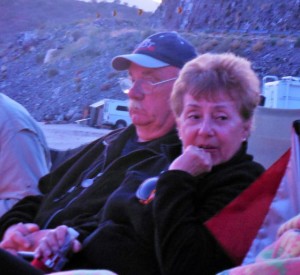
After writing an account of his Central American campaign (published in 1860 as War in Nicaragua), Walker once again returned to the region. British colonists in Roatán, in the Bay Islands, fearing that the government of Honduras would move to assert its control over them, approached Walker with an offer to help him in establishing a separate, English-speaking government over the islands. Walker disembarked in the port city of Trujillo, but soon fell into the custody of Commander Nowell Salmon (later Admiral Sir Nowell Salmon) of the British Royal Navy. The British government controlled the neighboring regions of British Honduras (now Belize) and the Mosquito Coast (now part of Nicaragua) and had considerable strategic and economic interest in the construction of an inter-oceanic canal through Central America. It therefore regarded Walker as a menace to its own affairs in the region.
Rather than return him to the US, Salmon delivered Walker to the Honduran authorities in Trujillo, who executed him near the site of the present-day hospital by firing squad on September 12, 1860. Walker was 36 years old and is buried in the Cementerio Viejo, in Trujillo.

Walker’s Legacy
William Walker convinced many Southerners of the desirability of creating a slave-holding empire in tropical Latin America. In 1861, when U.S. Senator John J. Crittenden proposed that the 36°30′ parallel north be declared as a line of demarcation between free and slave territories, some Republicans denounced such an arrangement, saying that it “would amount to a perpetual covenant of war against every people, tribe, and State owning a foot of land between here and Tierra del Fuego.”
Before the end of the American Civil War, Walker’s memory enjoyed great popularity in the southern and western United States, where he was known as “General Walker” and as the “grey-eyed man of destiny”. Northerners, on the other hand, generally regarded him as a pirate. Despite his intelligence and personal charm, Walker consistently proved to be a limited military and political leader. Unlike men of similar ambition, such as Cecil Rhodes, Walker’s grandiose scheming ultimately failed.
In Central American countries, the successful military campaign of 1856–57 against William Walker became a source of national pride and identity, and it was later promoted by local historians and politicians as substitute for the war of independence that Central America had not experienced. April 11 is a Costa Rican national holiday in memory of Walker’s defeat at Rivas. Juan Santamaría, who played a key role in that battle, is honored as one of the two Costa Rican national heroes, the other one being Juan Rafael Mora himself.
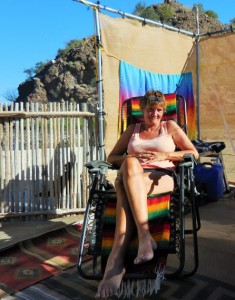
Films
Walker’s campaign has inspired two films, both of which take considerable liberties with his story: Burn! (1969) directed by Gillo Pontecorvo, starring Marlon Brando, and Walker (1987) directed by Alex Cox, starring Ed Harris. Walker’s name is used for the main character in Burn! though the character is not meant to represent the historical William Walker and is portrayed as British. On the other hand, Alex Cox’s Walker incorporates into its surrealist narrative many of the signposts of William Walker’s life and exploits, including his original excursions into northern Mexico to his trial and acquittal on breaking the neutrality act to the triumph of his assault on Nicaragua and his execution.

Books
In Part Five, Chapter 48, of Gone with the Wind, Margaret Mitchell cites William Walker, “and how he died against a wall in Truxillo”, as topic of conversation between Rhett Butler and his filibustering acquaintances, while Rhett and Scarlett are on honeymoon in New Orleans. In S. M. Stirling’s Emberverse Nantucket Books, a young Coast Guard lieutenant, William Walker, steals a ship loaded with modern technology from the time lost Nantucketers. Like the historical William Walker he embarks on a campaign for conquest and carves for himself a personal empire – in this case, in the Bronze Age, first in Britain, then fleeing to Greece. There he eventually overthrows Greek King Agamemnon, who commits suicide rather than be a puppet leader, and then proceeding to carry out his own brutal version of the Trojan War.
A long early poem by the Nicaraguan poet Ernesto Cardenal, Con Walker En Nicaragua, translated as With Walker in Nicaragua, gives a historical treatment of the affair. Nate DiMeo’s historical podcast The Memory Palace featured an episode on William Walker entitled “Presidente Walker”.


